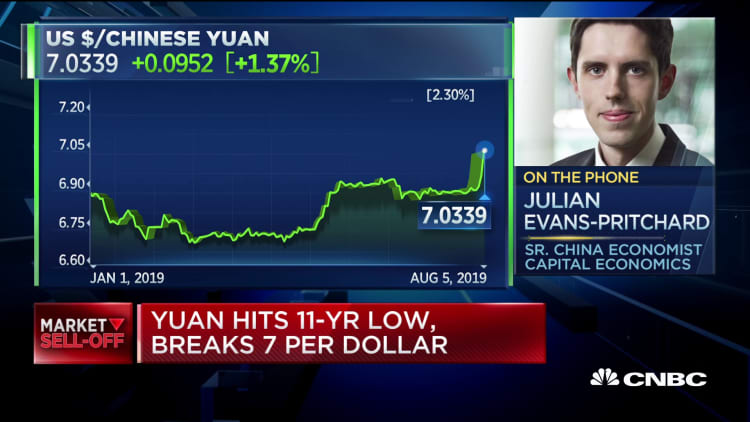China's central bank on Friday set the official midpoint reference for the yuan at 7.0136 per dollar — the weakest level since April 3, 2008 but stronger than what analysts were expecting.
It was the second time this week that the People's Bank of China set the daily benchmark at a weaker level than the psychologically important 7-yuan-per-dollar.
That followed Thursday's midpoint rate of 7.0039 yuan per dollar. Analysts were expecting China to set the midpoint at 7.0222 per dollar on Friday, according to Reuters estimates.
Onshore yuan traded at 7.0487 per dollar while the offshore yuan traded at 7.0725 at 2:42 p.m. HK/SIN Friday.
"The pressure on the yuan will be, if anything, on the downside as long as we have uncertainties surrounding the broader outlook in trade and some other issues," " Mikio Kumada, executive director and global strategist at LGT Capital Partners, told CNBC's "Street Signs" on Friday. "And also because the direction that the Chinese domestic economy is going is one that requires more stimulus and easing."
"That's not something that fundamentally strengthens a currency," he said.
The PBOC will "manage to keep (the yuan) broadly stable — probably for a while, it will keep a 7 handle and slightly north to 8. But I wouldn't expect too weak a yuan going forward either," Kumada added.
Trade uncertainties
Investors have been monitoring the onshore exchange rate closely this week after the yuan weakened past 7 per dollar on Monday for the first time since the global financial crisis in 2008. That in turn prompted the U.S. Treasury Department to designate China as a currency manipulator, a move no White House had exercised since the Clinton administration.
PBOC allows the local currency to fluctuate against the greenback within a narrow band of 2% from each day's midpoint. This is known as the onshore yuan whereas the less restrictive exchange rate used outside mainland China is known as the offshore yuan.
The Chinese central bank has denied it's devaluing the currency to counter American tariffs. Year-to-date, the onshore currency pair is down about 2.5%.
The yuan weakened in recent months against the dollar as the trade war between Beijing and Washington intensified. Last week, U.S. President Donald Trump unexpectedly announced 10% tariffs on another $300 billion of Chinese goods starting Sept. 1 even after the two countries restarted trade talks in Shanghai.
Both countries have placed levies on billions of dollars worth of each other's goods. Those developments have roiled markets for more than a year, and dampened growth prospects for the global economy.
China says market forces at play
In a Monday statement, China said the yuan weakening past 7 against the dollar was a normal exchange rate fluctuation between currencies, and that it was determined by market supply and demand. The State Administration of Foreign Exchange also added that the exchange rate wasn't expected to stay above 7 always, and depending on market conditions, that number can move up or down.
However, Citi analysts wrote in a Monday note that it could be the beginning of the Chinese currency weakening.
"It is likely that further depreciation actions could be in the pipeline should the trade war tensions escalate," the analysts said. "For the exchange rate policy to be used effectively, we could not rule out future one-off large depreciation, either, given China has already tightened its capital controls since end 2016."
Citi added that the risk of a repeat of large capital outflow "associated with the 2015-2016 depreciation episode" could be contained — but the "uncontrollable errors and omissions type of capital flight will continue." It would then require further monetary policy easing in China, according to the analysts.
A weaker yuan makes Chinese exports more attractive in international markets, and the Trump administration has frequently complained it's giving Beijing a trade advantage.
But, that could provide "significant headwinds for China's commodity imports in coming months," Vivek Dhar, senior analyst for mining and energy commodities research at the Commonwealth Bank of Australia, wrote in a Friday note. Some of those important commodities include iron ore, coal and gas.
Still, Beijing wants to keep the currency stable to avoid the uncertainties brought about by large depreciation, analysts have said.
WATCH: China is effectively weaponizing the exchange rate

— CNBC's Grace Shao contributed to this report.


